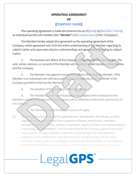What to Do If Your LLC Successor Doesn’t Want to Take Over the Business
You’ve spent years building your business. Maybe decades. And at some point, you started picturing the day you’d pass it on—probably to someone...
8 min read
LegalGPS : Aug. 8, 2025
When you combine family with business, everything feels more personal—because it is. Shared dreams, long histories, and emotional investments can strengthen your business… or tear it apart. That’s especially true with family-owned LLCs. What starts as a well-intentioned venture can unravel fast if expectations, roles, and ownership aren’t clearly defined.


Legal GPS Pro
Protect your business with our complete legal subscription service, designed by top startup attorneys.
This guide will walk you through how to prevent those disputes before they start—so your family business can stay both profitable and peaceful.
At first, everything runs smoothly. A couple siblings open a landscaping company. A parent and child start a real estate venture. Everyone’s excited. But over time, money gets involved, roles blur, and expectations diverge. And suddenly, the business starts to feel like a burden—or worse, a battleground.
Family LLCs are especially prone to disputes because of:
A 2021 study by PwC found that only 34% of family businesses have a robust, documented, and communicated succession plan. That means most are flying blind when ownership or leadership changes are needed.
These vulnerabilities aren’t just theoretical. Disputes over ownership or control can lead to drawn-out legal battles, damaged relationships, or even the loss of the business itself.
Next, we’ll walk through the single most important tool to prevent this from happening: a clear, detailed operating agreement.

LLC Family Trust Agreement
Use a Family Trust to keep LLC ownership in the family. This agreement can help protect assets across generations while supporting a clear succession and tax-efficient structure.
Trusted by 1,000+ businesses to safeguard their LLCs.
If you do nothing else to avoid family disputes, draft a strong operating agreement. It’s the legal backbone of your LLC—the document that outlines how your business runs, who owns what, and what happens if things go sideways. Without it, you're relying on state default laws and family goodwill—neither of which are predictable or tailored to your situation.
Three brothers started a landscaping LLC in Missouri. At first, things were simple—they each took on different roles: one managed equipment, one handled clients, and one did the books. But they also invested different amounts of money and had different schedules.
Because they had a detailed operating agreement, they were able to:
When one brother moved out of state and wanted to sell his interest, the agreement made the process smooth. No fights. No legal bills. Just a clean exit—and they’re still on good terms.
Here’s what a well-crafted operating agreement should cover:
Think of this agreement like a prenup for your business. You hope you won’t need the tough provisions, but you’ll be incredibly relieved they’re there if you do.
Build in a clause that requires mediation before any legal action. Mediation is cheaper, faster, and less combative than going to court. It also encourages family members to communicate and compromise.
Sample Provision:
“In the event of a dispute arising out of or related to this Agreement, the Members agree to first attempt to resolve the dispute through mediation before pursuing litigation or arbitration.”
A clause like this won’t solve every problem, but it can buy time and reduce tension when emotions run high.
It’s uncomfortable to think about what happens when you’re gone—or when someone in the family wants to leave the business. But not planning for succession is one of the fastest ways to create division. Without clear instructions, emotions take over, and disagreements can stall or destroy the business.
A father and daughter ran a boutique furniture business through an LLC. The father held 80% ownership; the daughter held 20%. When the father passed away unexpectedly, there was no succession clause in the operating agreement and no mention in his will.
The default state law passed his ownership interest to his spouse—who had never been involved in the business and wanted to sell her share immediately. The daughter, who had built the business alongside her father, was suddenly faced with the prospect of losing control or taking on a financial burden just to buy the share back.
It caused a major family rift and nearly tanked the business.
A good succession plan answers questions like:


Legal GPS Pro
Protect your business with our complete legal subscription service, designed by top startup attorneys.
There are different ways to structure this:
The key is to get it in writing and make sure every owner is on board.
Life changes—people get married, divorced, have kids, or develop new interests. A succession plan isn’t something you create once and forget. Put a reminder on the calendar every 2–3 years to review your operating agreement and any related estate planning documents.
Even just a 30-minute check-in can save your family months (or years) of conflict later on.
In a family business, people often assume roles without officially defining them. One sibling “handles the books,” another “manages the team,” and someone else “does whatever needs to get done.” But when things aren’t spelled out, confusion breeds resentment—especially when it comes to pay, authority, and accountability.
Two sisters co-owned a wedding planning LLC. One was the creative lead; the other managed operations and vendors. But over time, they clashed over money—specifically, who should be paid more and who was taking on more work.
They had no written job descriptions or agreed-upon responsibilities. Each thought the other was “slacking” in key areas. Resentment built, and they eventually dissolved the business, losing years of work and steady income.
If they’d simply documented roles and held monthly check-ins to talk through concerns, the business might still be thriving.
Documenting responsibilities helps avoid:
A good operating agreement can outline roles at a high level, but it’s also smart to create internal documents or policies that lay out specific duties, expectations, and reporting structures—even if it’s informal.
Even in a two-person family business, it helps to write down what each person is responsible for. This doesn’t have to be a formal HR process. A simple shared Google Doc works.
Once a quarter, sit down and ask:
Treating the business relationship like a professional one—even within family—helps everyone feel respected and heard.
In many family-owned businesses, decision-making can feel like a tug-of-war. Emotions run high, egos get involved, and personal history clouds objectivity. That’s why having a neutral third party—someone outside the family—can make a huge difference when it comes to major decisions.
These third parties might include:
This approach removes personal bias and keeps things focused on what's best for the business, not who has the loudest voice at the table.
You can build in language that gives a designated third-party advisor authority to break ties or weigh in on key issues. This ensures that if there’s ever a deadlock, you already have a process in place.
Sample Provision:
“In the event of a deadlock in decision-making among the Members, the issue shall be submitted to a mutually agreed upon Trusted Advisor, whose recommendation shall be given substantial weight in any subsequent decision.”
Pick someone with experience, credibility, and neutrality—and revisit the choice every few years as your business evolves.
One of the most overlooked causes of tension in family-run LLCs is blurring the line between personal and professional conversations. Business problems start leaking into holidays, Sunday dinners, and vacations—and suddenly, everything feels like work.
To avoid this, you need intentional boundaries between family time and business time. That doesn’t mean you have to act like corporate robots—it just means creating structure so the business doesn’t consume every interaction.
Here are a few simple strategies that work:
When everyone knows what to expect, it helps reduce surprises, drama, and burnout.
Even a quick 30-minute Zoom call or coffee meeting once a month can keep your business on track and your family life stress-free. Treat it like a real board meeting: show up prepared, review financials or updates, and make key decisions.
Try this simple recurring agenda:
Keeping business “in the business box” preserves relationships and helps the company run more professionally.
Sometimes, even with the best planning, disputes happen. Maybe something wasn’t documented clearly. Maybe emotions boiled over. Or maybe life just threw something unexpected at your family business. Whatever the cause, it’s important to deal with conflict early—before it turns into a lawsuit or long-term fallout.
Here’s a smart escalation process to follow:
A common mistake is waiting until the relationship is too far gone to fix. If you sense tension building—or if a conversation left you unsettled—act quickly. Even a single mediated session can prevent years of resentment.
Also, keep records of key decisions, agreements, and conversations. It’s not about mistrust—it’s about protecting everyone involved if memories (or emotions) get fuzzy later on.
The biggest question now is, "Do you need a lawyer for your business?” For most businesses and in most cases, you don't need a lawyer to start your business. Instead, many business owners rely on Legal GPS Pro to help with legal issues.
Legal GPS Pro is your All-In-One Legal Toolkit for Businesses. Developed by top startup attorneys, Pro gives you access to 100+ expertly crafted templates including operating agreements, NDAs, and service agreements, and an interactive platform. All designed to protect your company and set it up for lasting success.

Legal GPS Pro
Protect your business with our complete legal subscription service, designed by top startup attorneys.
|
Premium Template
Single-use Template |
Legal GPS Pro
Unlimited Access, Best Value |
|
|
| Choose Template | Learn More |
| Trusted by 1000+ businesses | |
Table of Contents

You’ve spent years building your business. Maybe decades. And at some point, you started picturing the day you’d pass it on—probably to someone...

Most LLC owners don’t expect to step away from their business suddenly. But whether due to retirement, illness, or death, ownership transitions can...

An LLC’s operating agreement serves as the foundation for governing the business, defining ownership rights, and outlining key decision-making...